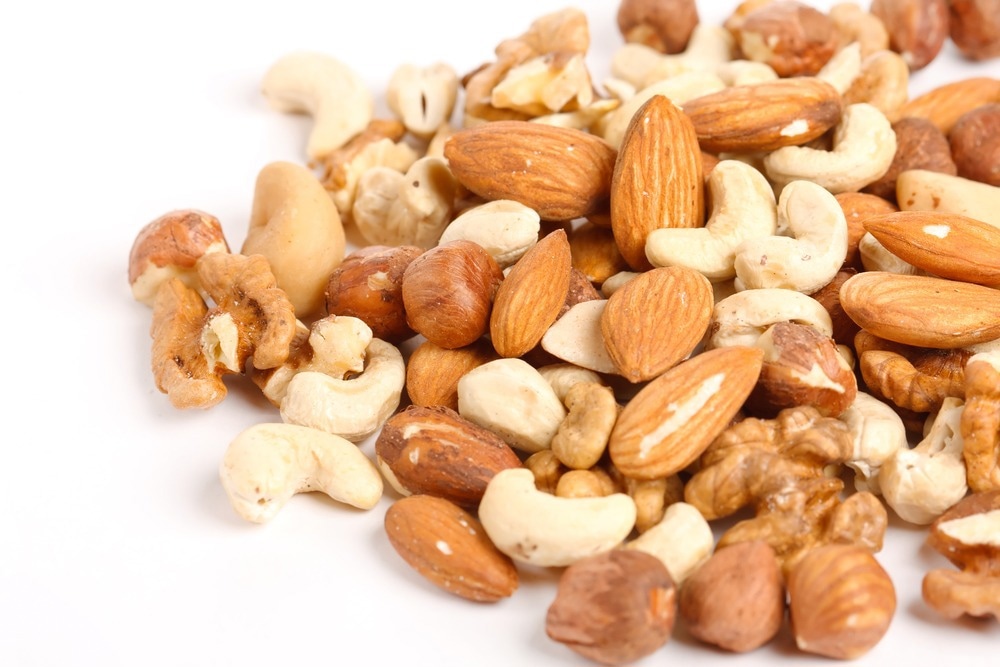In a recent review published in Nutrients, researchers summarize existing literature on the effects of consuming nuts on biomarkers of inflammation and oxidative stress.
 Study: Effect of Nuts on Markers of Inflammation and Oxidative Stress: A Narrative Review. Image Credit: Shebeko / Shutterstock.com
Study: Effect of Nuts on Markers of Inflammation and Oxidative Stress: A Narrative Review. Image Credit: Shebeko / Shutterstock.com
The health benefits of nuts
Inflammation and oxidative stress mediate the pathophysiology of various non-communicable diseases.
Notably, peanut and tree nut consumption has been shown to reduce the risk of developing certain cardiovascular and metabolic diseases, such as atherosclerosis, hypertension, and diabetes. Considering the known anti-inflammatory and anti-oxidative potential of nuts, the compounds within these food products may protect against inflammatory and oxidative processes.
In the present review, researchers elucidate the modulation of oxidative stress and inflammation by nut intake and present the scope for future research.
Oxidative and inflammatory processes
Tree nuts include Brazil nuts, walnuts, almonds, cashew, macadamia, hazelnuts, pine nuts, pistachios, and pecans.
Phytosterols, fiber, monounsaturated fatty acids (MUFA), polyunsaturated fatty acids (PUFAs), including linoleic acid and alpha‐linolenic acid, as well as mineral-type antioxidant molecules such as selenium, copper, and magnesium, in peanuts and tree nuts could enhance lipid metabolism and lower low‐density lipoprotein (LDL) levels.
In addition, antioxidants like tocopherols and polyphenols destroy free radicals, thereby inhibiting oxidative modification of low-density lipoprotein (oxLDL). These processes prevent the migration of monocytes, differentiation of macrophages, and subsequent oxLDL endocytosis by macrophage cells and foam cell formation.
Elevated free radical levels in sub-endothelial spaces alter smooth muscle cellular phenotypes, thus favoring oxLDL uptake. This process is critical in inducing and maintaining low levels of inflammation, during which elevated levels of cytokines such as interleukin-6 (IL‐6), tumour necrosis factor-alpha (TNF‐α), and other cytokines are often present.
Walnut intake has been associated with lower levels of TNF‐α, E‐selectin, interleukin‐6, granulocyte‐macrophage colony-stimulating factor (GM-CSF), IL‐ 1β, and interferon‐gamma (IFN-γ). Comparatively, hazelnuts can reportedly reduce vascular cell adhesion protein-1 (VCAM‐1) and C-reactive protein (CRP) levels.
Antioxidants in nuts can also directly eliminate reactive oxygen species (ROS) that are generated in cells, decrease oxidative stresses, and reduce the expression of nuclear factor-kappa B (NF-κβ) and release of pro‐inflammatory cytokines. Brazilian nuts have also been shown to exert positive effects on the selenium‐containing glutathione peroxidase (GPx) antioxidant enzyme activity.
Nut antioxidants also function as cofactors of various antioxidant enzymatic substances. Nuts can enhance antioxidant activity, elevate nuclear factor erythroid-related factor-2 (Nrf-2) gene expression, and upregulate antioxidant response element (ARE) genes. Walnuts may also improve the ferric‐reducing antioxidant property (FRAP).
Scope for future research
Cohort-type studies have been conducted to evaluate the relationship between nut consumption and inflammation. However, these studies lack oxidative stress biomarker evaluation nor have they assessed nut-conferred protection against disease outcomes.
Therefore, future studies must evaluate inflammatory and oxidative stress biomarkers that mediate exposure and outcomes of chronic diseases. Additional studies should also incorporate repeated dietary measures at follow‐up visits to eliminate bias related to lifestyle and behavioral changes with time.
Well-designed randomized controlled trials (RCTs) with large sample sizes are needed to build scientific evidence on the immunological and cardiometabolic benefits of consuming nuts. These studies should also evaluate oxidative and inflammatory biomarkers as primary study outcomes to clarify current inconsistencies.
Future clinical trials must consider the dose, which will typically be within the range of 40 g to 60 g daily, duration, and approaches that can be used to incorporate nuts into diets. Nut-free comparator diets, as well as adjustments for confounding factors such as age and gender, are also imperative to provide standardizable and generalizable data.
In addition, the medical history of individuals, including any history of obesity, type 2 diabetes, and cardiovascular diseases, must be assessed.
Future studies could also use metabolomic genetic signatures of inflammation, rather than individual biomarkers. This will allow researchers to explore underlying genetic and other mechanisms that contribute to the effects of nut intake on reducing cardiometabolic injury induced by oxidative and inflammatory pathways.
Furthermore, potential studies in the future should also incorporate deoxyribonucleic acid (DNA) methylation assays, analysis of the intestinal axis-immunological system relationship, and diet-based approaches, including the dietary inflammatory index (DII), to assess nut-induced protection against cardiometabolic diseases.
Conclusions
Nuts such as walnuts and almonds might preferentially regulate inflammation, whereas other nuts like Brazilian nuts might selectively alter oxidative stress levels.
Peanuts and tree nuts, which are rich in potent bioactive nutrient substances including PUFAs, MUFAs, alpha-tocopherol, copper, and selenium, and non‐nutrients including fiber, polyphenols, and phytosterols, have the potential to reduce cardiometabolic damage induced by oxidative stressors and inflammatory substances.
Nevertheless, the quality of available evidence is modest for a few nuts, inconsistent for some, and has not been assessed for many other types of nuts. Therefore, further research is essential to improve the current understanding of the protective role of nuts against inflammatory and oxidative processes.
Journal reference:
- Rajaram, S., Damasceno, N.R.T., Braga, R.A.M., et al. (2023). Effect of Nuts on Markers of Inflammation and Oxidative Stress: A Narrative Review. Nutrients 15(1099). doi:10.3390/nu15051099